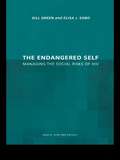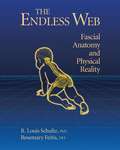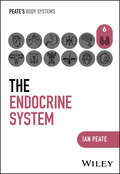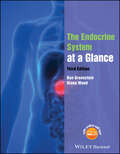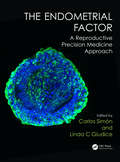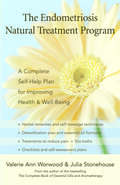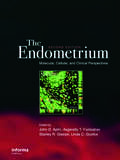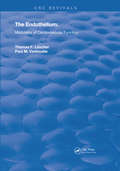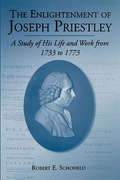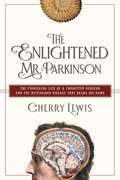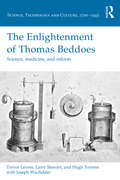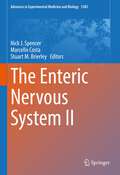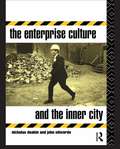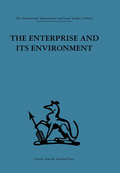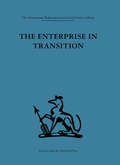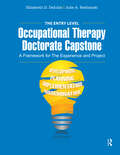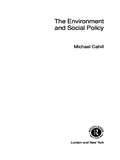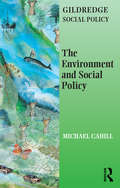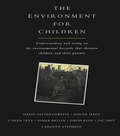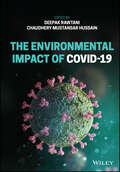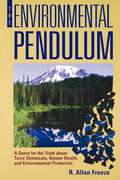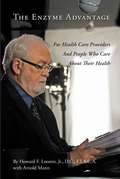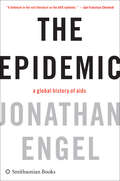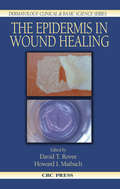- Table View
- List View
The Endangered Self: Identity and Social Risk
by Gill Green Elisa SoboTo date, the majority of HIV/AIDS research has concentrated on education and prevention for those with a seronegative status, while studies of HIV positive individuals have been concerned with their potential to infect others. The Endangered Self however, focuses on how the discovery of an HIV positive status affects the individual's sense of identity, on the experience of living with HIV and its effects on the individual's social relationships. In this comparative study of the UK and US, Green and Sobo explore identity change and the stigma attached to an HIV positive status within the context of the sociology of risk. Chapters discuss issues such as:*identity, social risk and AIDS*stigma*living and coping with HIV*the danger of disclosure*reported reactions in health care settings and sexual settings*risk and reality*seropositivity.The Endangered Self will be of interest to all those infected with HIV and to their families, partners, friends and caregivers who are affected by it. It will be essential reading for health-care professionals and those studying medical anthropology, sociology and health and risk studies.
The Endless Web: Fascial Anatomy and Physical Reality
by R. Louis Schultz Rosemary Feitis Ronald Thompson Diana SallesThe result of more than two decades of research and practice, The Endless Web presents in clear, readable language a comprehensive guide to understanding and working effectively with the myofascial system, the 'packing material' of the body. Myofascia is a flexible network of tissue that surrounds, cushions, and supports muscles, bones, and organs. It also acts as a riverbed containing the flow of interstitial fluid, and is a critical influence on the immune and hormonal systems. In daily life, this connective tissue is an underlying determinant of movement quality, modd, alertness, and general well-being. The Endless Web is a fully illustrated guide to understanding how myofascia works, it supportive role within the body's anatomy, and how gentle manipulation of the myofascial tissue is central to lasting therapeutic intervention and how it can be integrated into any bodywork practice.
The Endocrine System (Peate's Body Systems)
by Ian PeatePEATE???S BODY SYSTEMS THE ENDOCRINE SYSTEM A CONCISE, ILLUSTRATED, AND ACCESSIBLE GUIDE TO THE ENDOCRINE SYSTEM Each of the twelve volumes in Peate’s Body Systems series is rooted in the belief that a deep and thorough understanding of the human body is essential for providing the highest standard of care. Offering clear, accessible and up-to-date information on different body systems, this series bridges the gap between complex scientific concepts and practical, everyday applications in health and care settings. This series makes for an invaluable resource for those committed to understanding the intricacies of human biology, physiology and the various systems that sustain life. The Endocrine System is the perfect companion for students and newly registered practitioners across nursing and allied health fields with an interest in endocrinology, providing a comprehensive yet easy-to-digest guide for both academic and clinical application. Equips healthcare students and practitioners with the necessary information to provide safe and competent careFeatures colourful illustrations to aid comprehension, clarify complicated concepts, and render content more engaging and accessibleEmpowers readers to adapt to a rapidly evolving healthcare landscape, preparing them for the future of healthcare deliveryContains information necessary for effective patient care of those with hyper- and hypothyroidism, diabetes, and other diseases and conditions affecting the endocrine system
The Endocrine System at a Glance (At a Glance #42)
by Ben Greenstein Diana F. WoodThe Endocrine System at a Glance provides a highly illustrated and unambiguous introduction to the basic principles and mechanisms of endocrinology and the key endocrine organs, followed by sections on reproductive and metabolic endocrinology. Clinical scenarios contextualise the basic science and illustrate how endocrine conditions present, are diagnosed, and are treated on the wards. This third edition: Includes new material on basic diagnostic tests used in the diagnosis of endocrine disorders Features new material on cancer and endocrinology Includes MCQs for each chapter The Endocrine System at a Glance is ideal for all medical students studying endocrinology and revising for final exams, as well as preparing for clinical attachments. The book is also suitable for those training in allied health professions and nurses specialising in endocrinology.
The Endometrial Factor: A Reproductive Precision Medicine Approach
by Carlos Simón and Linda C. GiudiceAt the dawn of precision medicine, there is a new opportunity for novel approaches to understand, diagnose and treat endometrial disorders that affect fertility, reproductive outcomes, and women’s health more broadly. Herein, the editors have assembled critically evaluated state-of-the-art chapters presenting basic and clinical knowledge about the human endometrium that impacts or will impact clinical practice. All clinicians and researchers in Reproductive Medicine will find this book useful as a reference and a valuable tool for continued advancement in the understanding and management of the "endometrial factor".
The Endometriosis Natural Treatment Program: A Complete Self-Help Plan for Improving Health and Well-Being
by Valerie Ann Worwood Julia StonehouseBetween 10 and 15 percent of women suffer from endometriosis. Bestselling author Valerie Ann Worwood and health researcher Julia Stonehouse provide the definitive self-help natural treatment guide that can be used in conjunction with medical treatment to relieve the symptoms and help the body to heal.The program presents practical and easy-to-implement techniques that assist women in improving their overall health and well-being. The book explores the environmental toxins and other lifestyle issues that may contribute to endometriosis, and clearly explains simple ways to change these factors. Based on Worwood’s successful clinical practice, the authors’ multifaceted approach advocates specific natural health practices and a range of slow, steady lifestyle changes.
The Endometrium: Molecular, Cellular and Clinical Perspectives, Second Edition (Reproductive Medicine and Assisted Reproductive Techniques Series)
by John D Aplin Asgerally T Fazleabas Stanley R Glasser Linda C GiudiceThe first edition of The Endometrium was a landmark publishing event in reproductive biology and medicine. Many important developments have occurred in the field, and this new edition has been substantially updated and expanded to include new topics with an improved format. With the addition of several new authors and topics, the Second Edition of
The Endothelium: Modulator of Cardiovascular Function (Routledge Revivals)
by Thomas F. Luscher Paul M. VanhoutteFirst published in 1990: The Endothelium: Modulator of Cardiovascular Function takes a comprehensive look at the role of the endothelium in cardiovascular control in health and disease. Experts offer detailed reviews on specific topics that address these roles of the endothelium: diffusion barrier, blood-brain barrier, regulator of capillary permeability, metabolic function (uptake and enzymatic destruction), conversion of vasoactive products, production of prostanoids, production and release of endothelium-derived relaxing factors, production of endothelium-derived contracting factors, production of coagulation factors, production of fibrinolytic factors, reticulo-endothelial function, role in atherosclerosis, and changes in function with aging and disease. This overview provides the reader with an update on the role of one of the most fascinating cells in cardiovascular biology. It focuses on the multiple functions of those cells and offers the first attempt to draw a parallel between these functions. Anyone studying the fields of physiology and pharmacology will benefit from this "must have" reference resource.
The Enlightened Joseph Priestley: A Study of His Life and Work from 1733 to 1773
by Robert SchofieldJoseph Priestley (1733–1804) is one of the major figures of the English Enlightenment. A contemporary and friend of Benjamin Franklin and Thomas Jefferson, he exceeded even these polymaths in the breadth of his curiosity and learning. Yet no one has attempted an all-inclusive biography of Priestley, probably because he was simply too many persons for anyone easily to comprehend in a single study. Robert Schofield has devoted a lifetime of scholarship to this task. The result is a magisterial book, covering the life and works of Priestley during the critical first forty years of his life. <P><P>Although Priestley is best known as a chemist, this book is considerably more than a study in the history of science. As any good biographer must, Schofield has thoroughly studied the many activities in which Priestley was engaged. Among them are theology, electricity, chemistry, politics, English grammar, rhetoric, and educational philosophy. Schofield situates Priestley, the provincial dissenter, within the social, political, and intellectual contexts of his day and examines all the works Priestley wrote and published during this period. <P><P>Schofield singles out the first forty years of Priestley's life because these were the years of preparation and trial during which Priestley qualified for the achievements that were to make him famous. The discovery of oxygen, the defenses of Unitarianism, and the political liberalism that characterize the mature Priestley—all are foreshadowed in the young Priestley. A brief epilogue looks ahead to the next thirty years when Priestley was forced out of England and settled in Pennsylvania, the subject of Schofield's next book. But this volume stands alone as the definitive study of the making of Joseph Priestley.
The Enlightened Mr. Parkinson: The Pioneering Life Of A Forgotten Surgeon
by Cherry LewisA colorful and absorbing portrait of James Parkinson and the turbulent, intellectually vibrant world of Georgian London. Parkinson’s disease is one of the most common forms of dementia, with 60,000 new cases each year in the United States alone, yet few know anything about the man the disease is named after. In 1817—two hundred years years ago—James Parkinson (1755–1824) defined this mysterious ailment so precisely that we still diagnose Parkinson's Disease today by recognizing the symptoms he identified. The story of this remarkable man’s contributions to the Age of the Enlightenment is told through his three seemingly disparate passions: medicine, politics and fossils. As a political radical, Parkinson was interrogated over a plot to kill King George III and was in danger of exile. But simultaneously, he was helping Edward Jenner set up smallpox vaccination stations across London and writing the first scientific study of fossils in English, jump-starting a national craze. He is one of the intellectual pioneers of "the age of wonder," forgotten to history, but Cherry Lewis restores this amazing man to his rightful place in history with her evocative portrait of the man and his era.
The Enlightenment of Thomas Beddoes: Science, medicine, and reform (Science, Technology and Culture, 1700-1945)
by Larry Stewart Joseph Wachelder Trevor Levere Hugh TorrensThomas Beddoes (1760-1808) lived in ‘decidedly interesting times’ in which established orders in politics and science were challenged by revolutionary new ideas. Enthusiastically participating in the heady atmosphere of Enlightenment debate, Beddoes' career suffered from his radical views on politics and science. Denied a professorship at Oxford, he set up a medical practice in Bristol in 1793. Six years later - with support from a range of leading industrialists and scientists including the Wedgwoods, Erasmus Darwin, James Watt, James Keir and others associated with the Lunar Society - he established a Pneumatic Institution for investigating the therapeutic effects of breathing different kinds of ‘air’ on a wide spectrum of diseases. The treatment of the poor, gratis, was an important part of the Pneumatic Institution and Beddoes, who had long concerned himself with their moral and material well-being, published numerous pamphlets and small books about their education, wretched material circumstances, proper nutrition, and the importance of affordable medical facilities. Beddoes’ democratic political concerns reinforced his belief that chemistry and medicine should co-operate to ameliorate the conditions of the poor. But those concerns also polarized the medical profession and the wider community of academic chemists and physicians, many of whom became mistrustful of Beddoes’ projects due to his radical politics. Highlighting the breadth of Beddoes’ concerns in politics, chemistry, medicine, geology, and education (including the use of toys and models), this book reveals how his reforming and radical zeal were exemplified in every aspect of his public and professional life, and made for a remarkably coherent program of change. He was frequently a contrarian, but not without cause, as becomes apparent once he is viewed in the round, as part of the response to the politics and social pressures of the late Enlightenment.
The Enteric Nervous System II (Advances in Experimental Medicine and Biology #1383)
by Marcello Costa Nick J. Spencer Stuart M. BrierleyThis book is based on the proceedings of the Enteric Nervous System conference in Adelaide, Australia, under the auspices of the International Federation for Neurogastroenterology and Motility. The book focuses on methodological strategies and unresolved issues in the field and explores where the future is heading and what technological advances have been made to address current and future questions. The Enteric Nervous System II continues in the tradition of a popular earlier volume which covered the previous meeting. Many of the same authors are contributing to this new volume, presenting state-of-the-art updates on the many developments in the field since the earlier meeting. The coverage include a wide range of topics, from structure and function of the enteric nervous system through gut motility and visceral pain. The author team includes long-established authorities who significantly contributed to the advances in ENS research over the past two decades and the new generation that will continue to contribute to advancing our understanding of the field.
The Enterprise Culture and the Inner City
by John Edwards Nicholas DeakinThroughout the 1980s and into the 1990s, policy for inner city regeneration underwent a transformation from a reliance on central and local government activity and the use of public funds, to a much heavier dependence on private sector activities and private investment. In The Enterprise Culture and the Inner City, the authors offer a vigorous and critical investigation of government policy and, in response to the result of the 1992 general election and the implications of the Olympia and York Canary Wharf project, present a credible prediction for the future (or lack of future) of the inner city.
The Enterprise and its Environment: A system theory of management organization
by A K RiceTavistock Press was established as a co-operative venture between the Tavistock Institute and Routledge & Kegan Paul (RKP) in the 1950s to produce a series of major contributions across the social sciences. This volume is part of a 2001 reissue of a selection of those important works which have since gone out of print, or are difficult to locate. Published by Routledge, 112 volumes in total are being brought together under the name The International Behavioural and Social Sciences Library: Classics from the Tavistock Press. Reproduced here in facsimile, this volume was originally published in 1963 and is available individually. The collection is also available in a number of themed mini-sets of between 5 and 13 volumes, or as a complete collection.
The Enterprise in Transition: An analysis of European and American practice (International Behavioural And Social Sciences Ser. #Vol. 56)
by H Van Der HaasTavistock Press was established as a co-operative venture between the Tavistock Institute and Routledge & Kegan Paul (RKP) in the 1950s to produce a series of major contributions across the social sciences. This volume is part of a 2001 reissue of a selection of those important works which have since gone out of print, or are difficult to locate. Published by Routledge, 112 volumes in total are being brought together under the name The International Behavioural and Social Sciences Library: Classics from the Tavistock Press. Reproduced here in facsimile, this volume was originally published in 1967 and is available individually. The collection is also available in a number of themed mini-sets of between 5 and 13 volumes, or as a complete collection.
The Entry Level Occupational Therapy Doctorate Capstone: A Framework for the Experience and Project
by Elizabeth DeIuliis Julie BednarskiThe purpose of The Entry Level Occupational Therapy Doctorate Capstone: A Framework for The Experience and Project is to provide a step-by-step guide for the development, planning, implementation and dissemination of the entry-level occupational therapy doctoral capstone experience and project. The first entry-level occupational therapy doctorate program was established in 1999, but even now there is a scarcity of occupational therapy resources to guide faculty, prepare students and to socialize mentors to the capstone experience and project. The Entry Level Occupational Therapy Doctorate Capstone by Drs. Elizabeth DeIuliis and Julie Bednarski is the first available resource in the field of occupational therapy devoted to the doctoral capstone. Each chapter provides sample resources and useful documents appropriate for use with occupational therapy doctoral students, faculty, capstone coordinators and site mentors.Included Inside: Templates to develop the MOU, individualized doctoral student objectives, and evaluations Examples of how to structure capstone project proposals Learning activities to guide the literature search and development of a problem statement Strategies of how to approach sustainability and program evaluation of the capstone project Recommendations for structure and formatting of the final written document Additional scholarly products derived from the project Other scholarly deliverables including formats for professional presentations and submissible papers The Entry Level Occupational Therapy Doctorate Capstone: A Framework for The Experience and Project will be the first of its kind to serve as a textbook to provide recommendations that will benefit various stakeholders among the capstone team.
The Environment and Social Policy (The Gildredge Social Policy Series)
by Michael CahillFocusing on human welfare and the environment from a social policy perspective, this text shows how environmental concerns are becoming increasingly central to policy-making and discusses the roles of central and local government in relation to environmental issues.The Environment and Social Policy covers the following contemporary topics: sustainability, Local Agenda 21, green ideas, environmental health, housing and urban development, food, work and globalisation. Each chapter starts with an overview of the topic and ends with a list of key points and a guide to further reading. Core concepts are clearly explained and illustrated throughout this text which provides students with a concise and up-to-date summary of what they need to know.
The Environment and Social Policy (The Gildredge Social Policy Series)
by Michael CahillFocusing on human welfare and the environment from a social policy perspective, this text shows how environmental concerns are becoming increasingly central to policy-making and discusses the roles of central and local government in relation to environmental issues.The Environment and Social Policy covers the following contemporary topics: sustainability, Local Agenda 21, green ideas, environmental health, housing and urban development, food, work, globalisation. Each chapter starts with an overview of the topics and ends with a list of key points and a guide to further reading. Core concepts are clearly explained and illustrated throughout this text which provides students with a concise and up-to-date summary of what they need to know.
The Environment for Children: Understanding and Acting on the Environmental Hazards That Threaten Children and Their Parents
by David Satterthwaite et alEach year, millions of children die of environmental causes and many more suffer serious illness or injury. Children are often the most vulnerable to the condition of their environment -and their health is an index of its quality - but their wellbeing is rarely given priority by governments or aid agencies. Ironically, the problems can be traced back to matters which can be treated straightforwardly and at relatively low cost - poor drinking water or food, or infectious diseases which can be controlled. This book gives a multidisciplinary account of the environmental health hazards threatening children and the range of impacts they can have. It also explains what can be done, by communities as well as governments and aid workers, to provide safe and healthy environments for children. The book looks at conditions in a range of cities in the developing world, as well as pollutants and other health problems affecting children in the North. Published in association with UNICEF, and written by some of the same authors as Environmental Problems in Third World Cities (Earthscan, 1993), this provides excellent course material, and will be useful for practitioners working on child development, infant and maternal health, environmental health and community development. David Satterthwaite is Director of the Human Settlements Programme at the International Institute for Environment and Development, and principal author of Environmental Problems in Third World Cities (1993) and Squatter Citizen(1989).
The Environmental Impact of COVID-19
by Chaudhery Mustansar Hussain Deepak RawtaniTHE ENVIRONMENTAL IMPACT OF COVID-19 Discover the wider environmental effects of the COVID-19 pandemic with this up to date resource from leading voices in the field The Environmental Impact of COVID-19 delivers an insightful analysis of various environmental aspects of the COVID-19 pandemic that have caused global concern. The book discusses the transmission of COVID-19 in the environment, the pandemic’s environmental impact, risk mitigation and management, management of COVID-related waste, and the environmental implications of the virus. It also considers the socio-economic implications of COVID-19’s spread, including the effects of international lockdowns on different strata of society and various industries, including the biomedical industry, the environmental industry, and the pharmaceutical industry. An entire section of the text is devoted to a discussion about the waste generated due to COVID-19 and the effect of that waste on different environmental bodies. Another is dedicated to the impact of COVID-19 on the environment in the short- and long-term, including its effect on climate and climate change. Readers will also benefit from the inclusion of: A thorough introduction to the transmission of COVID-19 in the environment, including its viability in different environmental media and the effect of environmental factors in its transmission An evaluation and analysis of COVID-19, including traditional analytical techniques and sampling for COVID-19 and modern sensor-based techniques for identification An exploration of the socio-economic implications of COVID-19, including its effect on a variety of industries A treatment of the environmental impact of COVID-19 in the context of risk mitigation and management Perfect for academics and industry professionals whose work requires them to understand the wider environmental implications of the SARS-Cov-2 pandemic, The Environmental Impact of COVID-19 will also earn a place in the libraries of private sector professionals working on products and services that aim to reduce the environmental impact of the coronavirus.
The Environmental Pendulum: A Quest for the Truth about Toxic Chemicals, Human Health, and Environmental Protection
by R. Allan FreezeThe pendulum of environmental policy swings from one extreme to the other, depending on which camp is in power and who has the ear of the media. Underkill is followed by overkill. Concern breeds action; disillusion breeds reaction. The Environmental Pendulum provides a thoughtful and evenhanded assessment of this conflict. Tens of thousands of sites across the country are contaminated with toxic chemicals. Environmentalists warn us that this legacy of carelessness is seriously affecting both human health and the ecological balance of nature. They point out that even improved industrial practices will not eliminate future chemical releases to the environment. Their demand for regulatory control has received wide public support and led to the passage of the Superfund legislation in 1980. Now, after twenty years, the value of the Superfund program is being challenged by corporate America, which argues that excessive cleanup costs have the potential to bankrupt the nation. R. Allan Freeze outlines the difficulties associated with the management of hazardous waste and offers a balanced account of the controversy over the role of environmental contamination in human health. Freeze clarifies what matters and what doesn't with respect to chemical contaminants in the environment, arguing that environmental policies should be based on an accurate appraisal of the risks associated with these toxins. He concludes the book with a brilliant summation of the good news and the bad news of environmental pollution, describing what can and can't be done to bring the situation under control.
The Enzyme Advantage: For Health Care Providers And People Who Care About Their Health, First Edition
by Arnold Mann Howard F. LoomisThe book answers the question:'why we need enzyme'. The Enzyme Advantage is a resource book for all health care providers and people who care about their health.
The Epidemic: A Global History of Aids
by Jonathan EngelFrom the Castro bathhouses to AZT and the denial of AIDS in South Africa, this sweeping look at AIDS covers the epidemic from all angles and across the world. Engel seamlessly weaves together science, politics, and culture, writing with an even hand—noting the excesses of the more radical edges of the ACT UP movement as well as the conservative religious leaders who thought AIDS victims deserved what they got. The story of AIDS is one of the most compelling human dramas of our time, both in its profound tragedy and in the extraordinary scientific efforts impelled on its behalf. For gay Americans, it has been the story of the past generation, redefining the community and the community's sexuality. For the Third World, AIDS has created endless devastation, toppling economies, social structures, and whole villages and regions. And the worst may yet be to come: AIDS is expanding quickly into India, Russia, China, and elsewhere, while still raging insub-Saharan Africa.A distinguished medical historian, Engel lets his characters speak for themselves. Whether gay activists, government officials, public health professionals, scientists, or frightened parents of schoolchildren, they responded as best they could to tragic happenstance that emerged seemingly from nowhere. There is much drama here, and human weakness and heroism too. Writing with vivid immediacy, Engel allows us to relive the short but tumultuous history of a modern scourge.
The Epidemiology of Aging
by Anne Newman Jane A. CauleyThe average age of the world's population is increasing at an unprecedented rate and this increase is changing the world. This "Silver tsunami" emphasizes the need to provide advanced training in epidemiology and increase the cadre of experts in the study of aging. This book is designed to summarize unique methodological issues relevant to the study of aging, biomarkers of aging and the biology/physiology of aging and in-depth discussions of the etiology and epidemiology of common geriatric syndromes and diseases. Contributing authors in the book represent many disciplines, not only epidemiology and clinical geriatrics, but also demography, health services, research, cardiovascular disease, diabetes, psychiatry, neurology, social services, musculoskeletal diseases and cancer. The aim of the book is to provide a broad multidisciplinary background for any student/researcher interested in aging. The material in the book is organized and comprehensive. It represents the most up-to-date information on the scientific issues in aging research written by academics who specialize in research and training in the broad field of aging. The structure and organization of the book reflects our course series in the Epidemiology of Aging starting with the broad issues of demography and methodology, and then addressing specific health conditions and geriatric conditions common to older persons.
The Epidermis in Wound Healing
by Howard I. Maibach David T. RoveeNew biological techniques and a revival of interest in both acute and chronic wound healing have led to an enormously improved understanding of the cellular and chemical complexities of the healing process. Exciting developments in the evolution of epidermal biology are creating new opportunities for research and clinical applications in wound heal
